Armstrong was a prolific collage artist, using photographs, letters, promotion materials, newspaper articles and more to create art on the walls of his home, in scrapbooks and on 500 reel-to-reel tape boxes which are part of the Armstrong Archives. Here are some of our favorites. Visit some of the originals on display at the Here to Stay Exhibition at the Louis Armstrong House Museum in Corona, Queens.
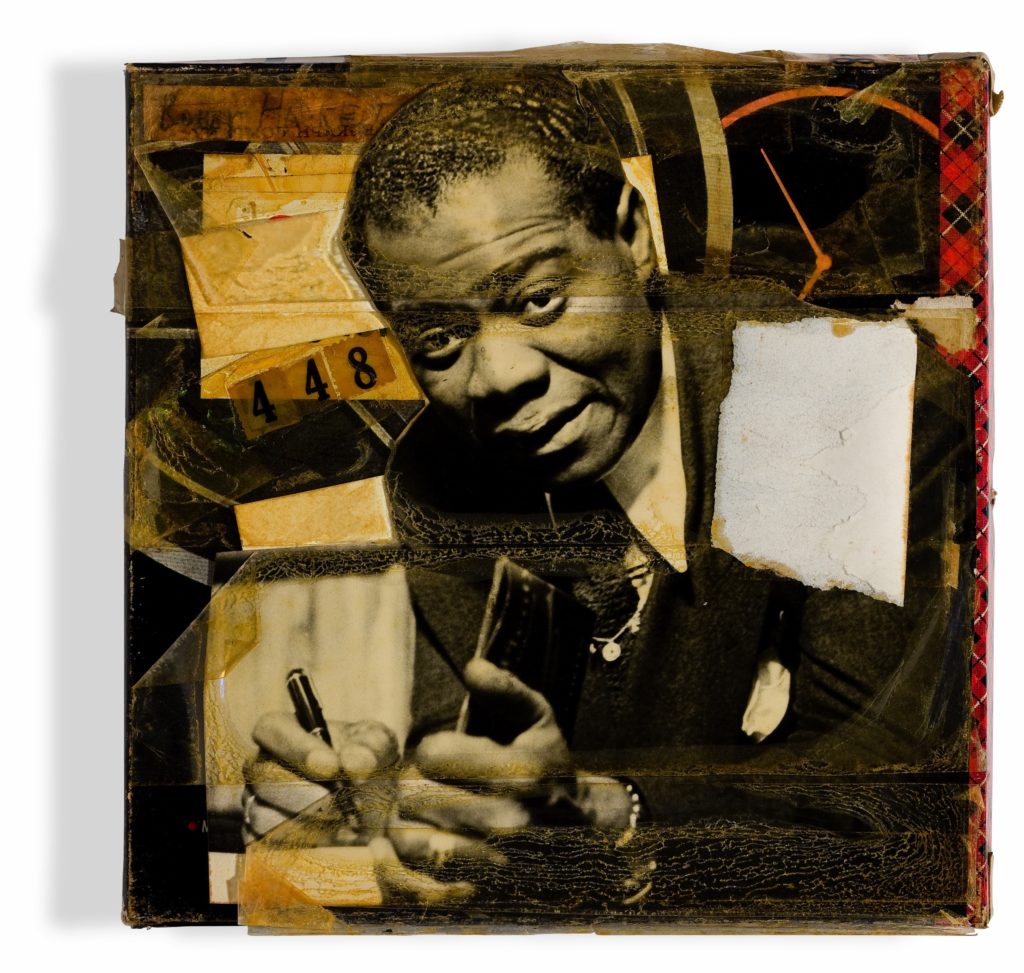
Accession Number: 1987.3.313
Louis Armstrong Collection
Reel 448 shows Armstrong in the middle of one of his most frequent offstage habits, signing autographs. In this instance, Armstrong signs a copy of Robert Goffin’s biography, Horn of Plenty, perhaps a bit wearily. Armstrong soon went to work on his own first person account of his life, published in 1954 as Satchmo: My Life in New Orleans.
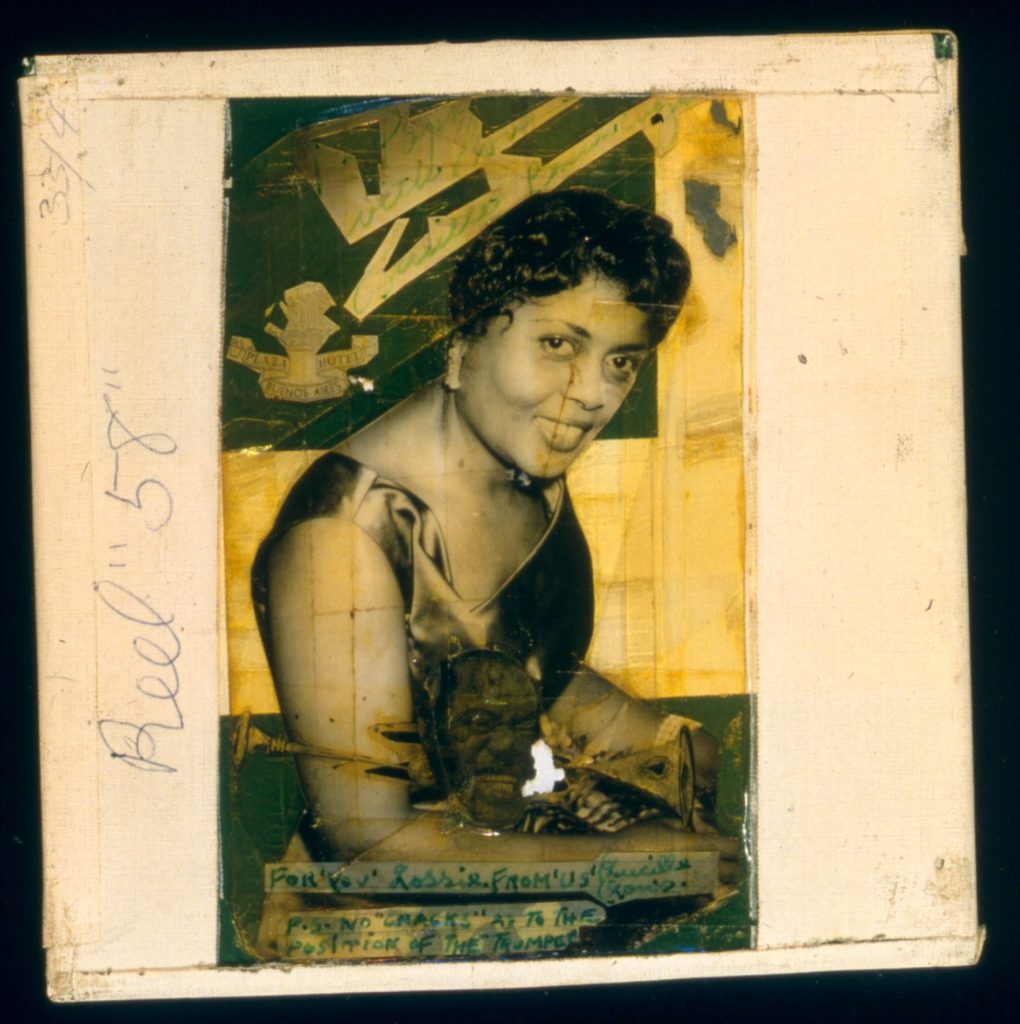
Accession Number: 1987.3.358
Louis Armstrong Collection
Lucille Wilson Armstrong was a frequent subject for her husband’s collages, such as the one that adorns Reel 58. Though our eye is immediately attracted to Lucille, a closer look reveals almost undetectable hidden images of Louis and a trumpet.
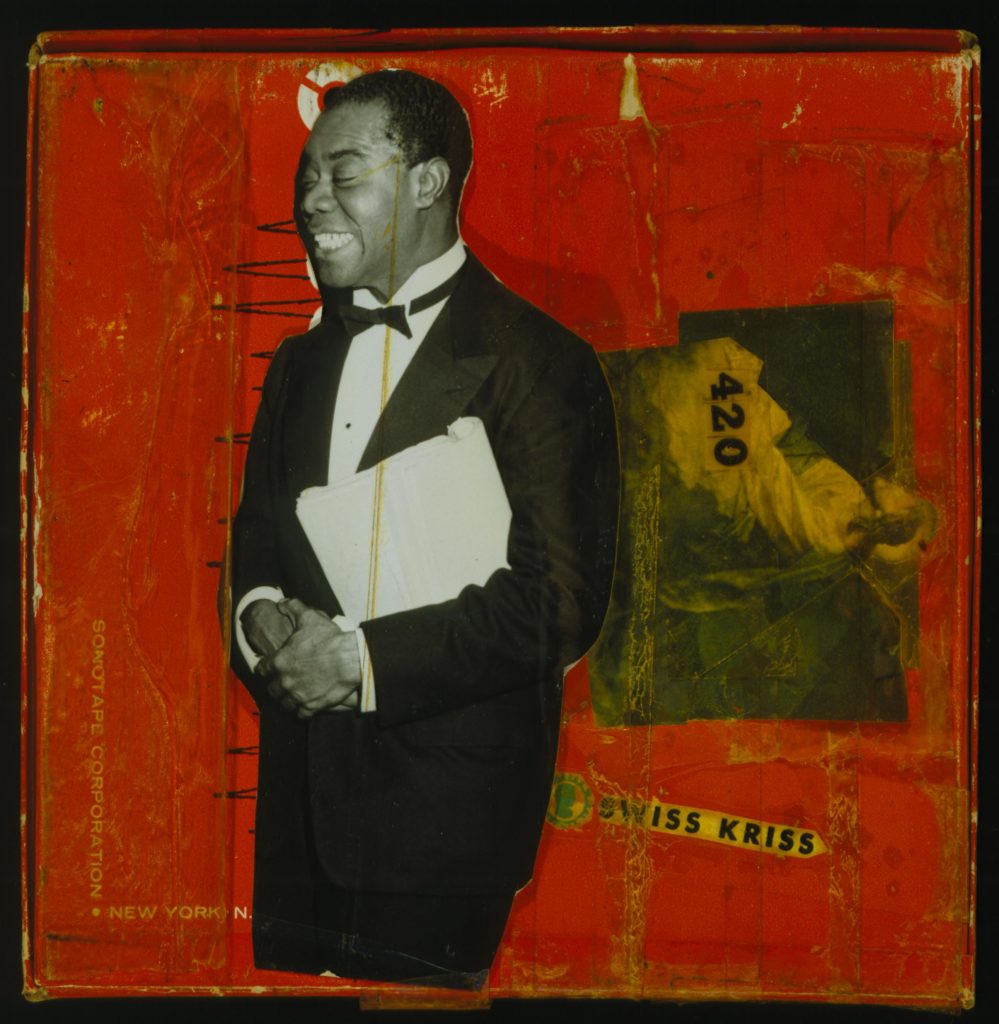
Accession Number: 1987.3.295
Louis Armstrong Collection
The collage for Reel 420 might be best known as the cover image of Steven Brower’s acclaimed book, Satchmo: The Wonderful World and Art of Louis Armstrong, published by Abrams. This particular collage features a publicity photo of Louis from the time he made the film New Orleans in 1946, an image of Jesus, and the words of his laxative of choice, Swiss Kriss, all taped onto a striking red background.
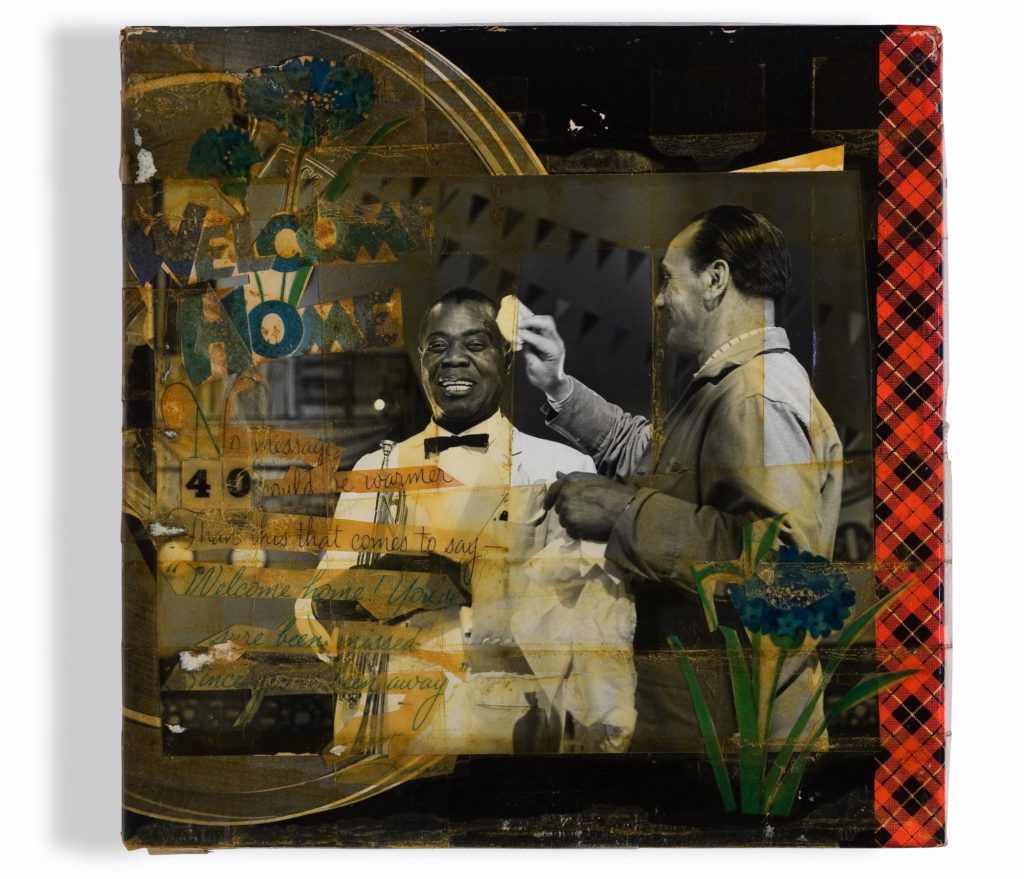
Accession Number: 1987.3.73
Louis Armstrong Collection
After a nearly six-month long tour of Europe in 1959, Armstrong received a “Welcome Home” greeting card, using it to take up the majority of the left side of the collage on Reel 40. On the right side is a photograph from that grueling tour, taken during the filming of the German movie, La Paloma. In that film, Armstrong strode out onstage in his white suit to sing “Uncle Satchmo’s Lullaby” with child star Gabrielle Clonisch. In this photo, a crew member tends to Armstrong between takes.
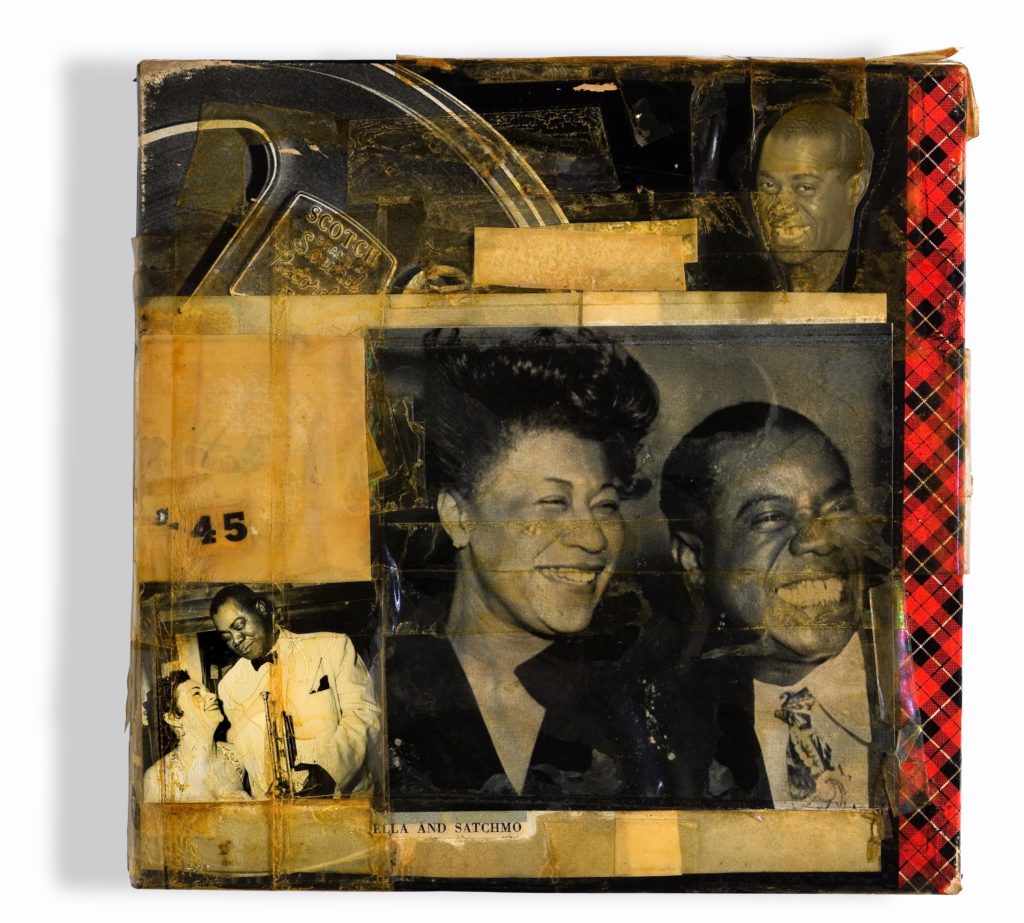
Accession Number: 1987.3.80
Louis Armstrong Collection
The music Ella Fitzgerald made with Louis Armstrong in the 1940s and 50s is the definition of timeless. Armstrong first met Fitzgerald when she was singing with Chick Webb’s Orchestra in the late 1930s, but the two did not make any recordings together until 1946. After a series of successful singles for Decca (including the immortal “Dream a Little Dream of Me,”), Ella and Louis moved over to Verve for three legendary albums, Ella and Louis, Ella and Louis Again, and Porgy and Bess. Armstrong once said he’d take the latter album with him to a mythical desert island but it was the 1956 Ella and Louis LP that became the last album he listened to on July 5, 1971, passing away the following morning. Elsewhere on this collage is a photo of Armstrong in his dressing room with an unnamed woman, plus at the top, a floating Armstrong head, something that often appears in his collage work.
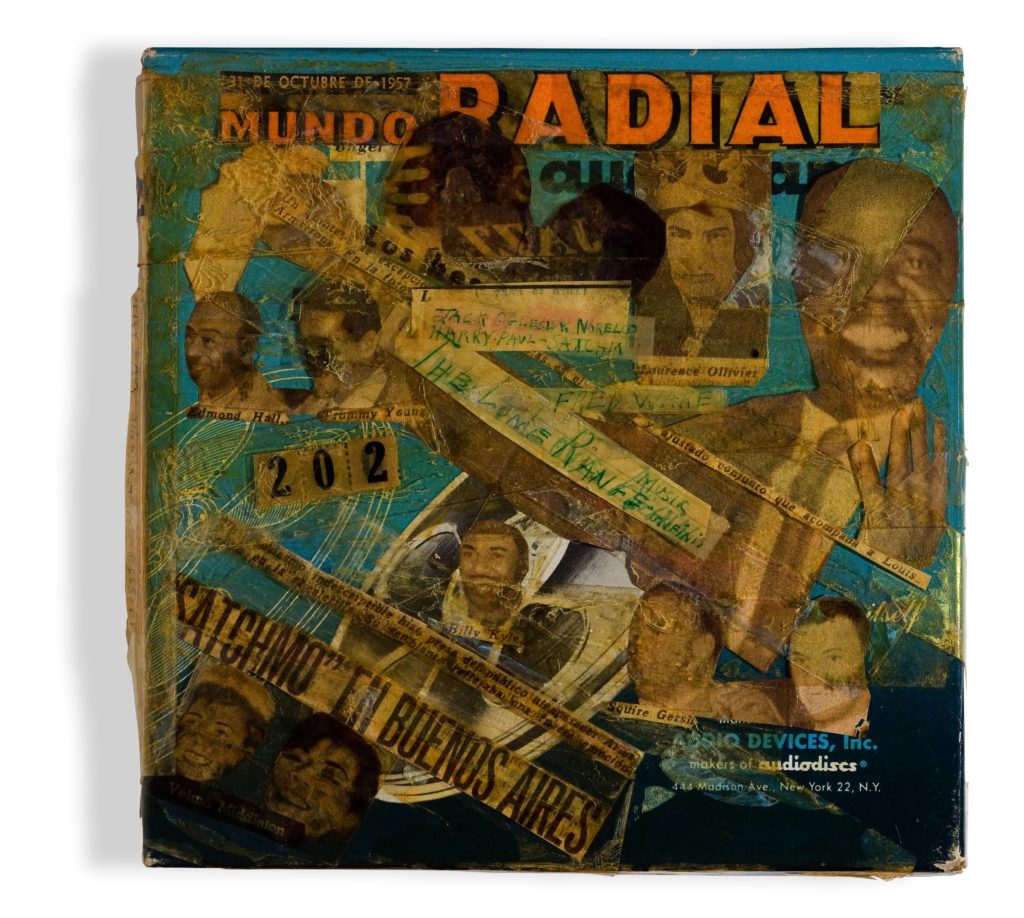
Accession Number: 1987.3.273
Louis Armstrong Collection
Armstrong made numerous headlines during his 1957 tour of South America — headlines that adorns nearly the entire front of Reel 202. With a copy of the October 31, 1957 Mundo Radial in his grasp, Armstrong cut out multiple articles and captions from an article about “‘Satchmo’ En Buenos Aires.” Armstrong clipped out photos of himself and his All Stars–trombonist Trummy Young, clarinetist Edmond Hall, pianist Billy Kyle, bassist Squire Gersh, drummer Barrett Deems, vocalist Velma Middleton, an unknown kissing couple, and for good measure, Laurence Olivier! Armstrong also noted that the tape reel itself had appearances from friends Jack Oglesby and Fred Ware, a demonstration of a Norelco tape recorder and episodes of The Lone Ranger.
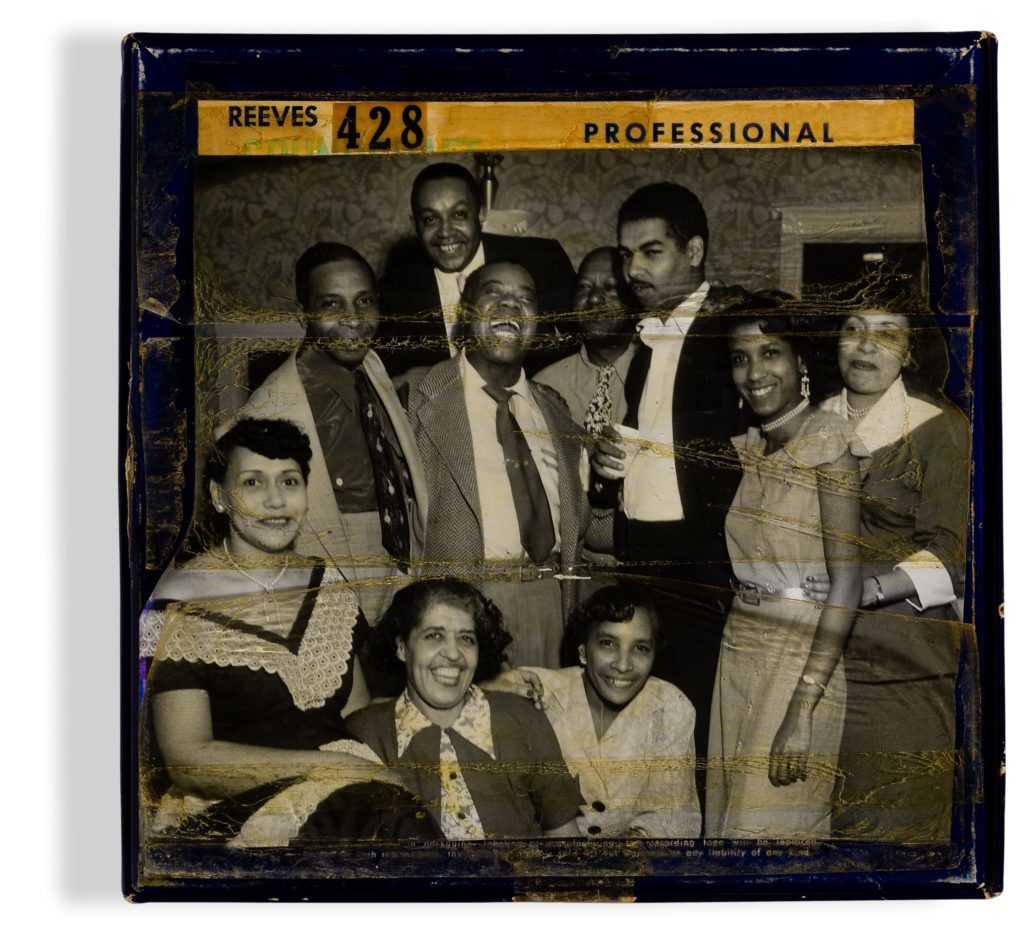
Accession Number: 1987.3.302
Louis Armstrong Collection
Though he was at home with celebrities, other musicians, and even royalty, Armstrong was most comfortable entertaining neighborhood folks at his Queens home, as seen in the collage for Reel 428. The Armstrongs moved to Corona in 1943, originally sharing the two-family house with Lucille Wilson Armstrong’s mother, Maude Perry. After her passing in 1946, Louis and Lucille began spreading out around the entire house, with Louis getting a den of his own. Meanwhile Lucille began utilizing the services of interior decorator Morris Grossberg to keep their home looking fresh–and often covered the walls from floor-to-ceiling with bold prints of wallpaper, as can be glimpsed in the background of this photo, which most likely dates from the late 1940s or early 1950s. Unfortunately, the names of the others in this image have become lost to posterity but we can certainly assume that they had some memorable times at the Armstrong House!
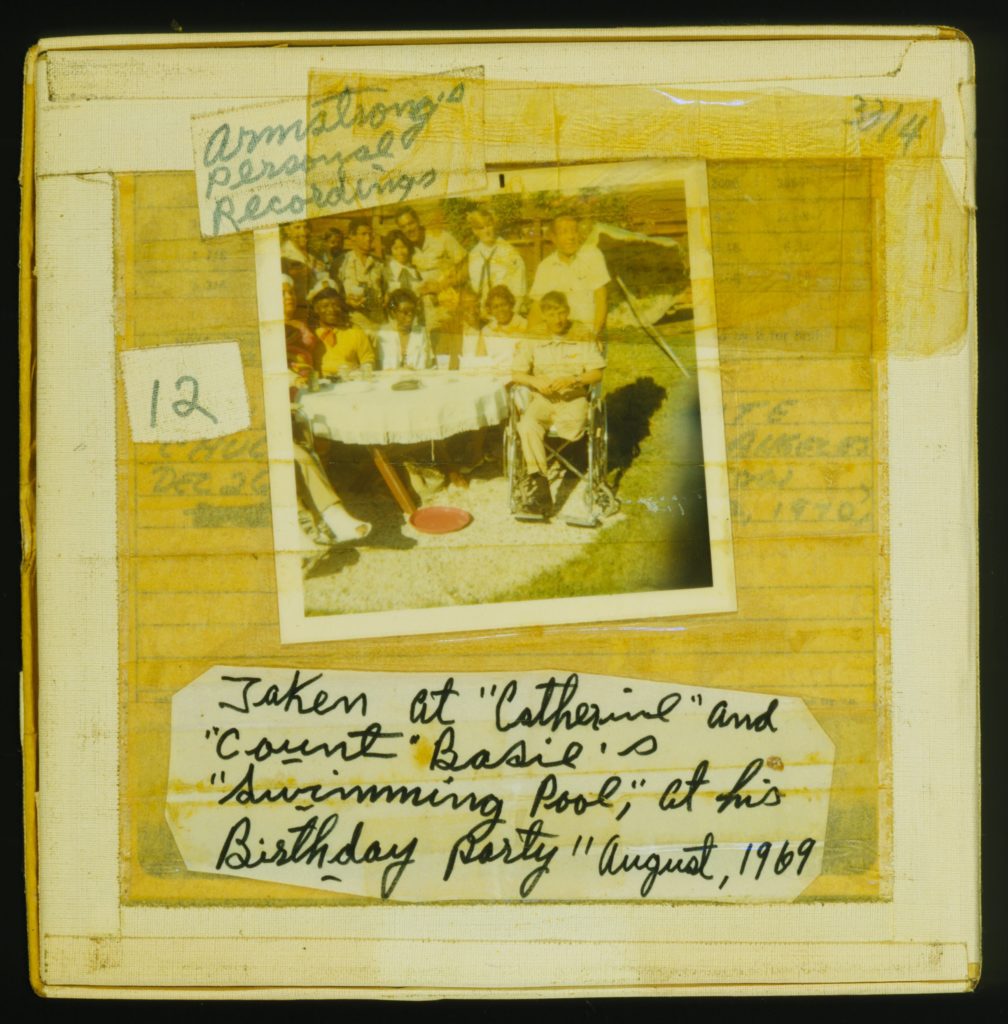
Accession Number: 1987.3.324
Louis Armstrong Collection
Armstrong himself contributed the caption to Reel 12, which features a snapshot of Louis and Lucille at the Queens home of another jazz legend, Count Basie. Louis Armstrong wasn’t the first jazz musician to move to Queens–Clarence Williams, Bix Beiderbecke, and Fats Waller were some of the other big names to move there earlier–but after World War II, the borough became an attractive destination for musicians who wanted to be close to the bustling Manhattan jazz scene, but who also wanted a taste of the suburbs, with backyards, swimming pools, and all that went with it. In addition to Armstrong and Basie, Queens was also the home of Dizzy Gillespie, Clark Terry, Cannonball Adderley, Illinois Jacquet, Bobby Hackett, Billie Holiday, Jimmy Heath, Roy Eldridge, Milt Hinton, and many other legends of the music.
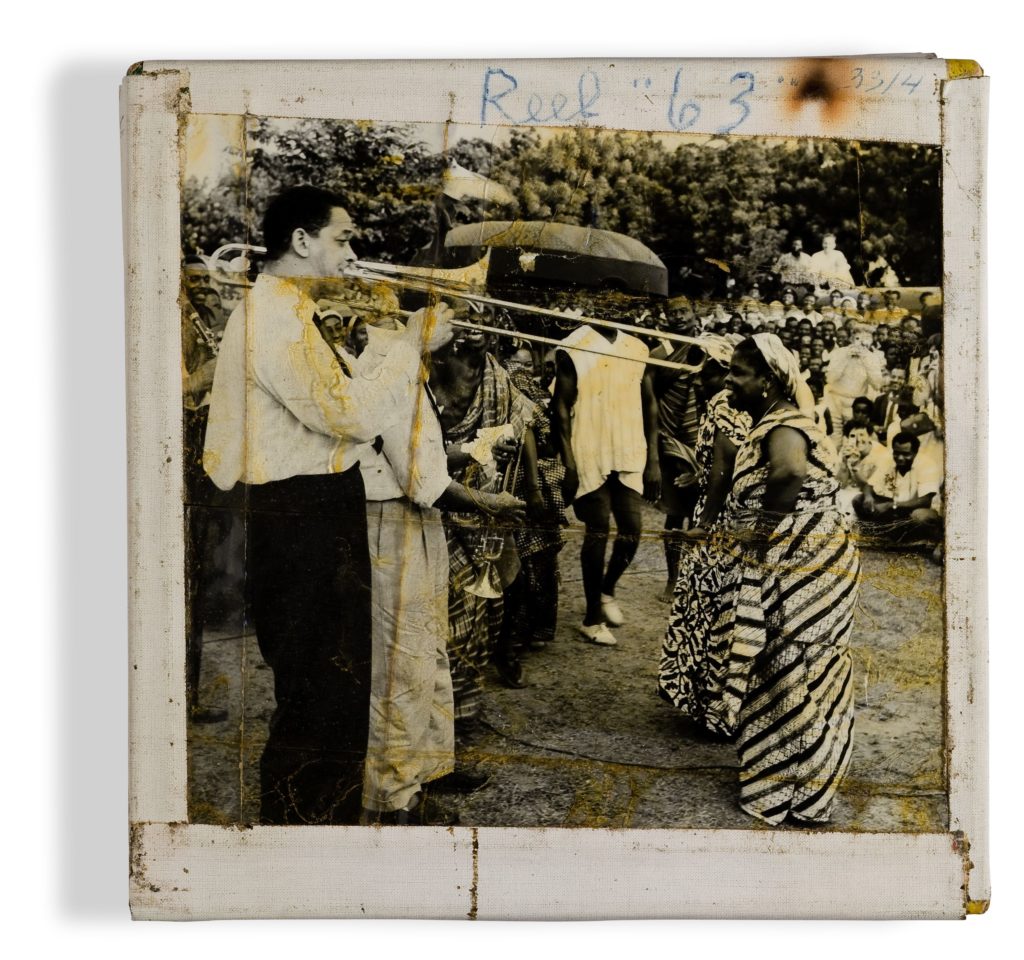
Accession Number: 1987.3.363
Louis Armstrong Collection
In 1955, Louis Armstrong’s riotous international tour made headlines around the world, with help from CBS newscaster Edward R. Murrow, who filmed part of the tour for his prime time series See It Now. The segment on Armstrong proved so popular, Murrow decided to expand it into what would become the theatrical documentary Satchmo the Great. The climax of that film occurred in the Gold Coast of Africa, soon to become the independent nation of Ghana. In the middle of an open field, Armstrong and his All Stars launched into an exciting performance of “Royal Garden Blues” as the audience danced and Murrow’s cameras rolled. Armstrong was especially moved when he spotted a dancer who he said looked just like his mother, actually putting his trumpet down to marvel at her. That moment was captured by photographers and was immortalized on the front of Reel 63.
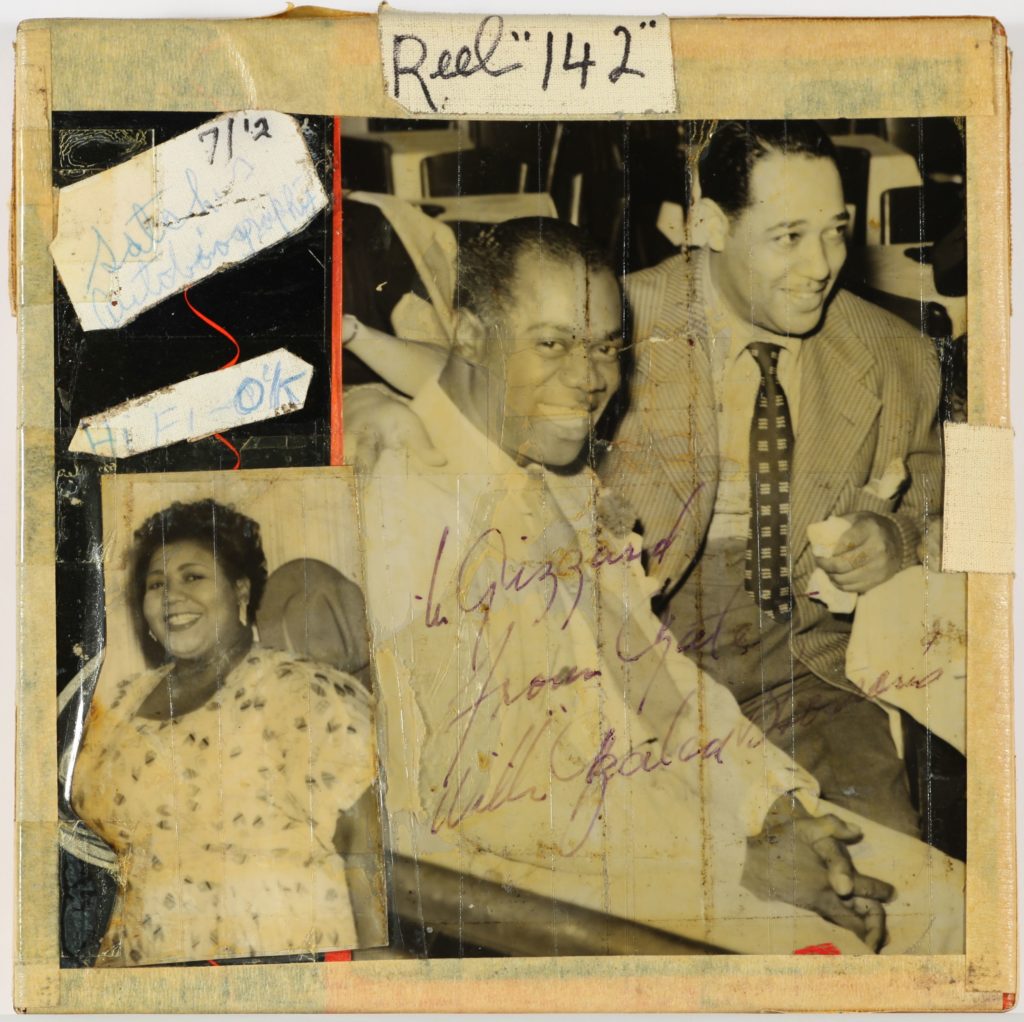
Accession Number: 1987.3.440
Louis Armstrong Collection
Much of the history of jazz can be traced back to Louis Armstrong and Duke Ellington, both of whom appear on the collage on the front of Reel 142. The two giants initially met in New York in the 1920s and immediately formed a mutual appreciation society. Ellington almost always featured an Armstrong-inspired trumpeter in his orchestra, while Armstrong recorded Duke’s “Solitude” in 1935 and performed other Ellington compositions such as “Do Nothing Til You Hear From Me” and “Perdido” in live settings. They finally recorded together for the first time in 1946 but didn’t truly collaborate until April 1961, when they recorded enough material for two full-length albums over the course of two days. The results, including masterpieces such as “Azalea,” “Mood Indigo,” “The Beautiful American,” and many more, are considered high-water marks in both Armstrong and Ellington’s discographies. Coincidentally, it was the first album Armstrong recorded after the passing of his longtime vocalist Velma Middleton, who appears in the lower left corner of this particular collage. Middleton joined Armstrong in 1942 and remained with him until her untimely death in Sierra Leone, Africa in February 1961. She was only 46 years old. Her show-stopping duets with Armstrong remain beloved to this day.
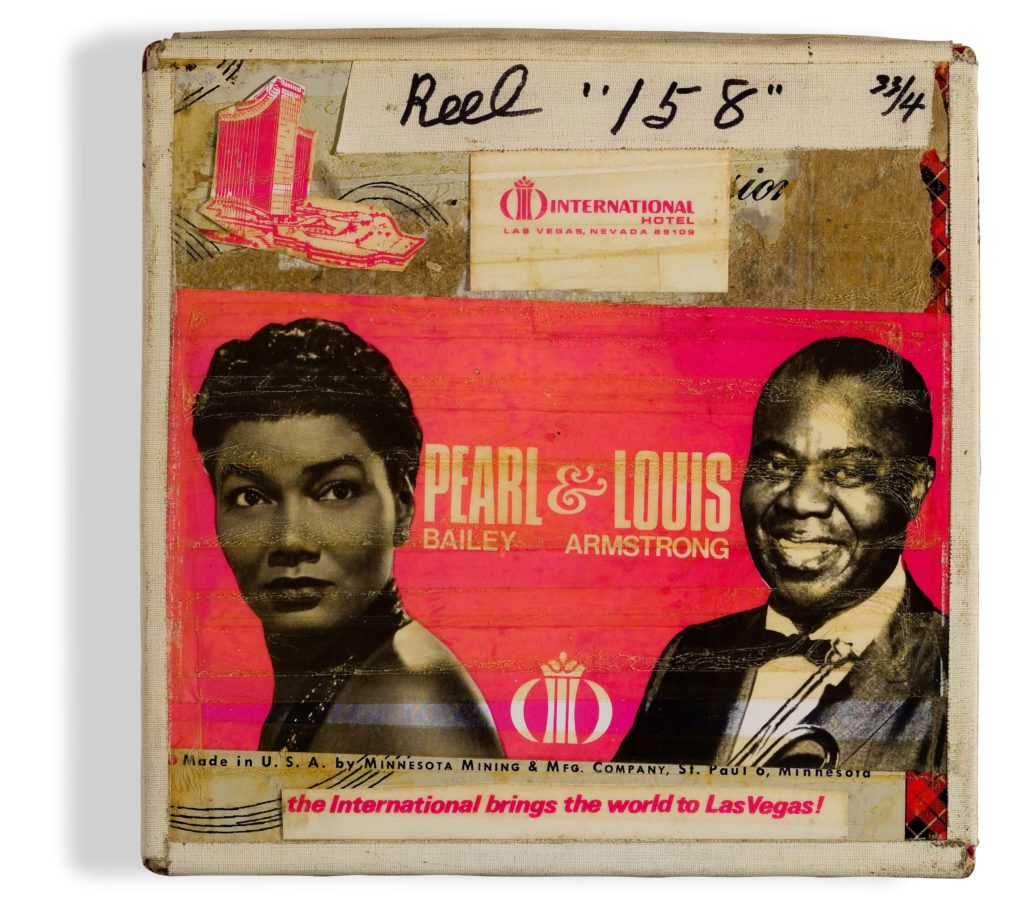
Accession Number: 1987.3.456
Louis Armstrong Collection
In September 1968, Louis Armstrong showed up at his doctor’s office having difficulty breathing. He had been performing almost nonstop for 55 years but it was now time to check himself into Beth Israel Hospital. Armstrong spent two long stints in intensive care, finally returning home to Queens in the spring of 1969. Doctors let him know that the best thing for him to do would be to retire from performing and to just enjoy his life at home with Lucille. Louis listened–to a point. He stayed off stage but continued practicing the trumpet each and every night until finally cleared to perform again in public in September 1970. Armstrong reunited his All Stars band and made his comeback at the International Hotel in Las Vegas, sharing the bill with vocalist Pearl Bailey. Bailey and Armstrong initially teamed up on an episode of The Mike Douglas Show in March 1970 and showed an immediate rapport. Armstrong received a standing ovation from the audience in Vegas and was invited to appear on the inaugural episode of Bailey’s television variety show in January 1971. It was all too much, too soon as Armstrong eventually had a heart attack in March 1971 and passed away four months later, but he managed to immortalize his International Hotel comeback in the collage on Reel 158.
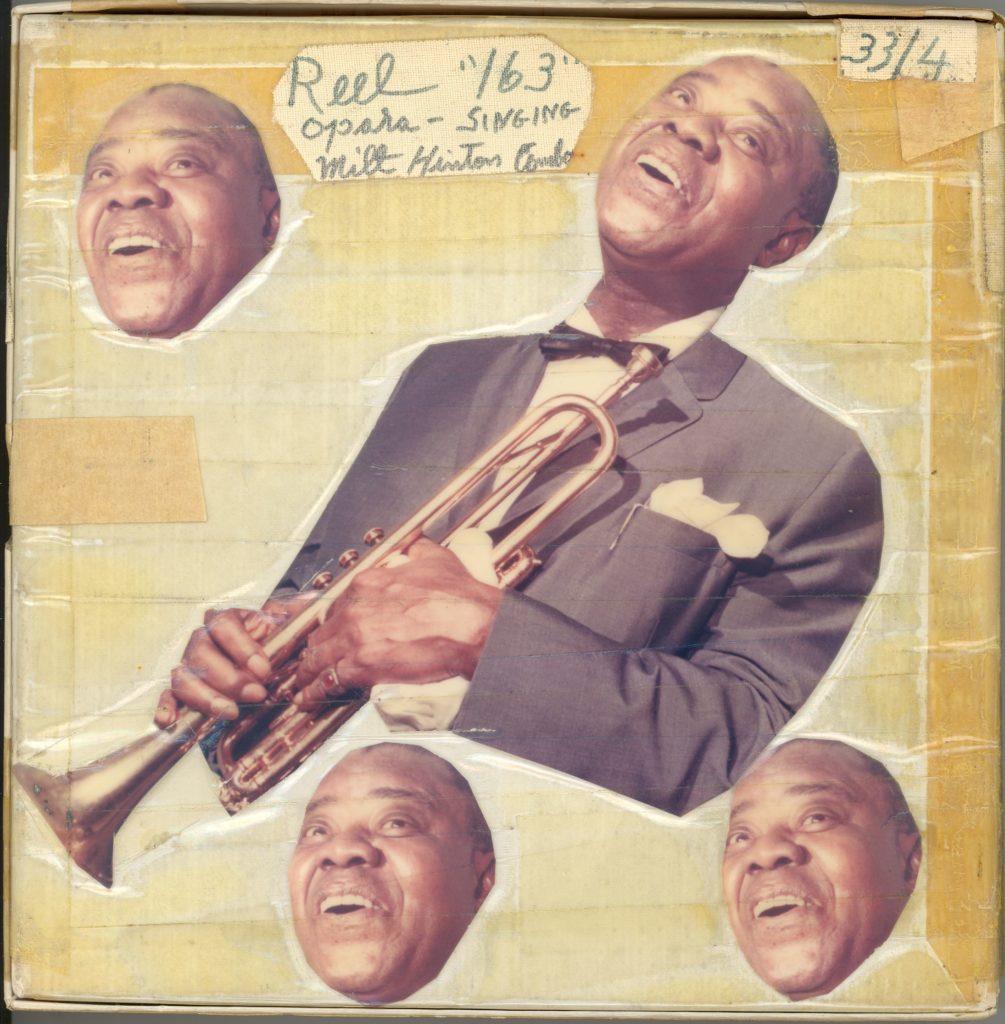
Accession Number: 1987.3.461
Louis Armstrong Collection
Louis Armstrong had a legendary sense of humor, often infusing his live performances with jokes and expert showmanship. Offstage, Armstrong was often the life of the party, always quick with a joke or a story to keep his company laughing. That jocularity often translated into Armstrong’s collages, perhaps best exemplified by the collage on Reel 163. Armstrong often carried multiple copies of his publicity photos as he was often besieged by autograph seekers and even spent much of his alone time signing and sending autographs for his fans around the world. With multiple copies of the same color 1960s publicity photo at hand, Armstrong went to work with his scissors and tape, eventually completing a collage made up of a quartet of singing Armstrongs!
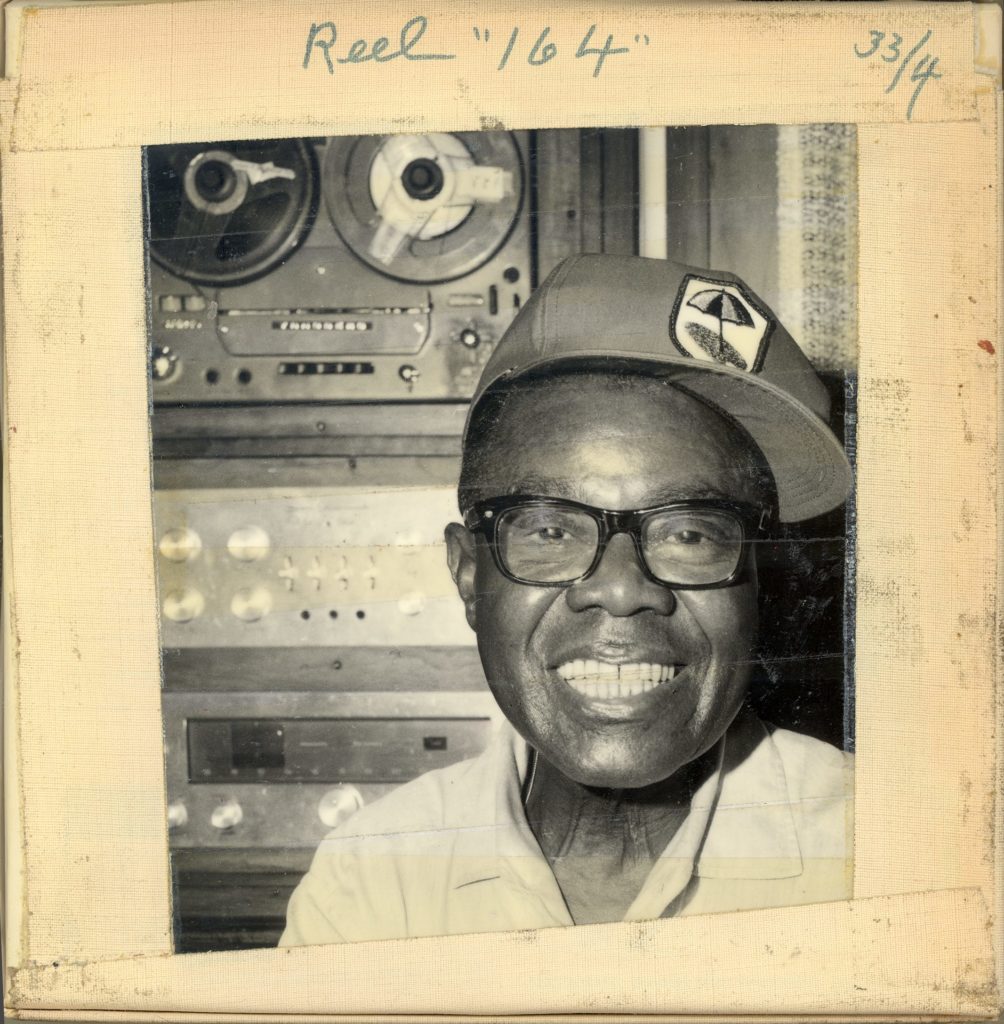
Accession Number: 1987.3.462
Louis Armstrong Collection
Most of Armstrong’s collages were made in the den of his Corona, Queens home, where he is pictured in the photo on Reel 164. The den went through many permutations over Armstrong’s 29 years in Corona. In the 1950s, his love of collage spilled onto the walls of his den, which he adorned with photographs, newspaper clippings, and anything else he had at hand, eventually covering portions of his ceiling! Lucille Armstrong eventually grew tired of this look and had the collages taken down and replaced with wallpaper in the early 1960s. As the decade wore on, Armstrong seemed to lose interest in his reel-to-reel tape hobby, rarely making any new tapes or collages. While Louis was in intensive care in 1968, Lucille sensed that her husband’s performing days were behind him and had the den remodeled with a set of brand new Tandberg tape decks installed behind his new desk. The enticement worked and though Louis continued practicing the trumpet when he returned home and eventually returned to the stage, he also spent much of his final two years in that room, making over 200 reel-to-reel tapes and collages, in addition to numerous scrapbooks and autobiographical manuscripts. This photo was taken in July 1970, one year before he passed away; the handwriting on the box is that of Lucille’s, who helped her husband catalog his tapes in his final days.
More about the collages of Louis Armstrong can be found in this post on That’s My Home.



